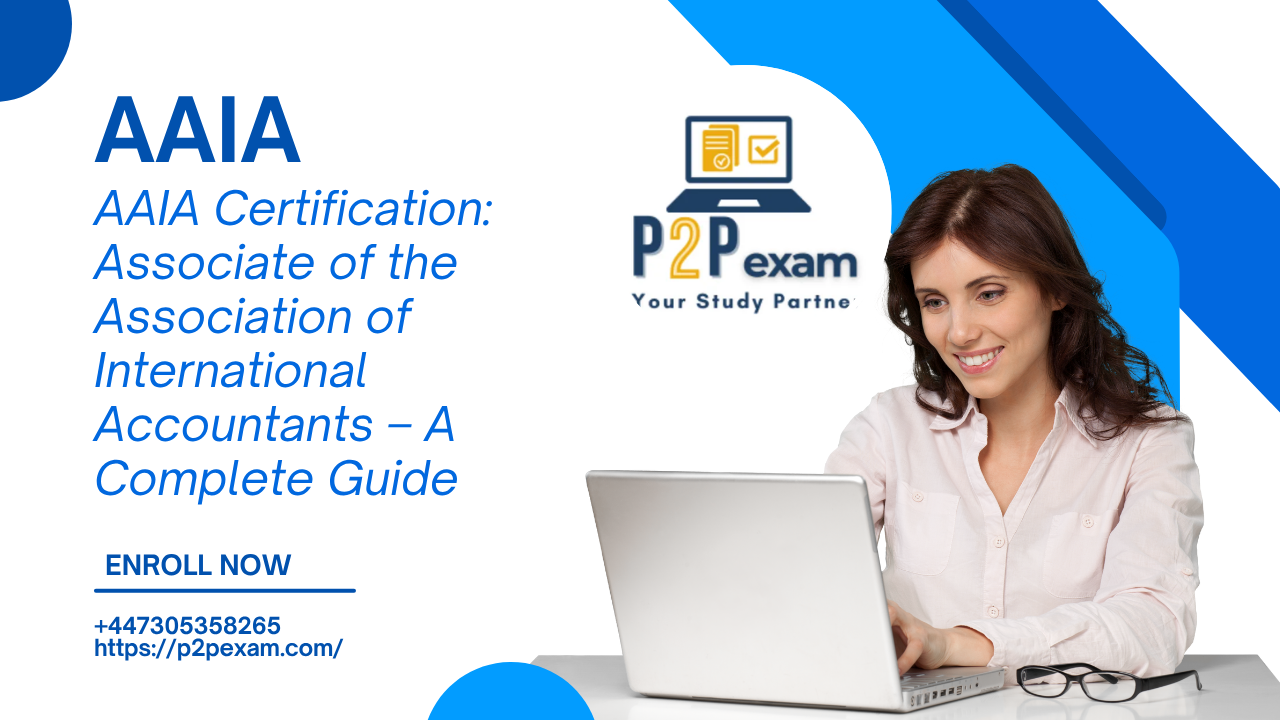AAIA Certification: Associate of the Association of International Accountants – A Complete Guide

Strong 8k brings an ultra-HD IPTV experience to your living room and your pocket.
One internationally recognised professional accounting credential is the Associate of the Association of International Accountants (AAIA). It is given out by the Association of International Accountants (AIA), a professional organisation with headquarters in the UK that was established in 1928 with the goal of advancing and growing the accounting industry globally.
Joining the AAIA community entails being a part of a professional community dedicated to high standards in corporate governance, taxation, auditing, and financial management. Everything you need to know about the AAIA designation will be covered in this article, including its advantages, eligibility requirements, exam format, and employment opportunities.
What is AAIA?
Those who have finished the AIA Professional Qualification and acquired relevant real-world work experience are granted the AAIA designation. It shows that a candidate satisfies the necessary technical, ethical, and professional standards and acts as evidence of proficiency in accounting, finance, and business.
After becoming an AAIA, members can use the post-nominals "AAIA" and work in roles such as:
• Financial Accountant
• Auditor
• Tax Consultant
• Financial Controller
• Management Accountant
Why Choose the AAIA Qualification?
1. Global Recognition
Many nations, particularly those in Europe, Asia, and Africa, recognise AIA. Because it is a Recognised Qualifying Body (RQB) in the UK, members of the AAIA are eligible to obtain licenses to perform audit work.
2. Flexible Pathway
Students and working professionals can more easily manage their time between work and study thanks to the AIA's flexible learning and exam schedule.
3. Comprehensive Curriculum
Both technical accounting skills and more general business knowledge in areas like strategy, leadership, and corporate law are provided by the AAIA qualification.
4. Professional Development
In order to stay current with industry trends, members have access to webinars, journals, and career support resources in addition to opportunities for continuous professional development (CPD).
Structure of the AIA Professional Qualification
The journey to becoming an AAIA involves passing three levels of exams and completing practical work experience.
1. Foundation Level (3 Papers)
These exams are ideal for beginners and cover core financial topics:
• Financial Accounting 1
• Management Accounting 1
• Business Economics
2. Professional Level 1 (6 Papers)
• Financial Accounting 2
• Management Accounting 2
• Financial Management
• Auditing
• Law
• Taxation
3. Professional Level 2 (6 Papers)
• Financial Reporting
• Business and Corporate Law
• Management Information
• Corporate Finance
• Business Strategy
• Advanced Taxation
Students typically require 3 to 4 years to complete all levels, depending on exemptions and study pace.
Practical Experience Requirement
To qualify for AAIA membership, candidates must demonstrate 3 years of relevant work experience in accounting or finance. This work can be full-time or part-time and must cover key areas such as:
• Financial reporting
• Audit and assurance
• Taxation
• Business strategy
• Financial management
Experience must be verified by a qualified accountant or employer, and logged through AIA’s online portal.
Eligibility Criteria
You can begin your journey to AAIA with:
• A high school diploma or equivalent (for entry at Foundation Level)
• A bachelor’s degree in accounting or business (may qualify for exemptions)
• Relevant professional qualifications (e.g., ACCA, CIMA, CPA, CA)
AIA offers exemptions based on your academic and professional background. This can significantly reduce the time and cost to become an AAIA.
Exam Format
• Mode: Online or paper-based, depending on region
• Frequency: Exams are held twice a year – typically in May and November
• Type: Multiple-choice, short questions, and scenario-based questions
Most exams are 3 hours long, and the passing mark is 50%.
Cost of AAIA Qualification
The cost varies depending on location, exemptions, and chosen training provider. Here's a rough breakdown:
• Registration Fee: £50 - £100
• Annual Subscription Fee: £100 - £150
• Exam Fees per Paper: £70 - £150
• Study Material/Training: £500 - £1,500 (optional)
Some candidates get sponsorship from employers or scholarships offered by training institutes.
Career Opportunities with AAIA
The AAIA qualification opens doors to a wide variety of careers in both the public and private sectors. Some roles include:
• Financial Analyst: Analyzing financial data and trends to support business decisions
• Auditor: Examining financial records for accuracy and regulatory compliance
• Management Accountant: Budget planning, cost analysis, and strategic financial decisions
• Tax Advisor: Offering guidance on tax planning and compliance
• Finance Manager: Leading financial planning, budgeting, and reporting
AAIA professionals are hired by:
• Accounting and auditing firms
• Government agencies
• Multinational corporations
• Non-profits and NGOs
• Startups and SMEs
Continuing Professional Development (CPD)
To retain AAIA membership, professionals must complete a minimum of 40 hours of CPD each year, including:
• Online courses
• Industry seminars
• Technical webinars
• Self-directed learning
This ensures members remain up to date with evolving accounting practices and regulations.
Progression to Fellow Status – FAIA
After 5 years of post-qualification experience, AAIA members can apply for Fellow Membership (FAIA). This senior-level designation provides:
• Enhanced credibility
• Access to more leadership roles
• Networking with senior finance professionals globally
How to Get Started
Here’s a step-by-step roadmap:
1. Register with AIA and choose your study level based on your qualifications.
2. Prepare using AIA-approved study resources or third-party training providers.
3. Sit Exams for each paper, at your pace.
4. Log Practical Experience using AIA's tools and have it verified.
5. Apply for AAIA Membership upon passing all exams and meeting experience requirements.
6. Maintain Your Membership through CPD and ethical compliance.
👉 For exam resources, preparation material, and real AAIA exam questions, visit.
Note: IndiBlogHub features both user-submitted and editorial content. We do not verify third-party contributions. Read our Disclaimer and Privacy Policyfor details.



